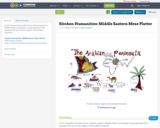
In this 7th grade humanities lesson, students prepare a Middle Eastern meze platter using ingredients that represent the four climatic regions of the Arabian Peninsula.
- Subject:
- Arts and Humanities
- Material Type:
- Activity/Lab
- Date Added:
- 02/19/2014

In this 7th grade humanities lesson, students prepare a Middle Eastern meze platter using ingredients that represent the four climatic regions of the Arabian Peninsula.

L!NX is the Rosa Luxemburg Foundation's new digital learning platform for self-learners and multipliers/educators in search of basic political content - with a critical eye and from a left-wing perspective.
The content ranges from globalization and trade, history and culture, economy and labor, migration, anti-racism and anti-fascism to organizing, climate justice and food sovereignty.
With interactive, multimedia and short formats, we want to establish a platform where it is possible to take the first steps in political education autonomously. The platform should also become a place where multipliers can find materials and content for their own workshops and seminars.
The Rosa Luxemburg Foundation (external link, opens in a new window) is one of the largest providers of political education in the Federal Republic of Germany. It sees itself as part of the basic intellectual current of democratic socialism.
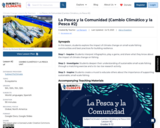
SYNOPSIS: In this lesson, students explore the impact of climate change on small-scale fishing communities and best practices for building resilience.
SCIENTIST NOTES: In this lesson, students explore how climate change is changing industrial fishing. This lesson passes our scientific review process.
En esta lección, los estudiantes exploran cómo el cambio climático está cambiando la industria pesquera. Esta lección pasa nuestro proceso de revisión científica.
POSITIVES:
-This lesson builds on lesson 1 of the Cambio Climático y la Pesca unit by providing real-life examples of what students experienced in the role-playing game, El Juego de Peces.
-The authentic texts, game, and student choice in this lesson engage students in discovering new information while developing their Spanish language skills and increasing their capacity for intercultural understanding.
-In this lesson, students are invited to explore the topic of gender equity through data and by listening to the voices of women in the small-scale fishing industry.
ADDITIONAL PREREQUISITES:
-This is lesson 2 of 3 in our Cambio Climático y la Pesca unit.
-To successfully navigate this lesson, students should be at an intermediate-low proficiency level.
-Students familiar with the imperfect tense will be prepared to understand the interviews in the videos in which fisher people describe their childhoods.
-Students with the ability to use the present subjunctive will have the opportunity to employ this concept to express recommendations, doubts, and perspectives.
DIFFERENTIATION:
-The Conecto game in the Inquire section can be played in small groups or pairs by sharing the link with students.
-Students may want to watch the video in the Inquire section one time with the closed captions off and then again with the Spanish closed captions on.
-The tic-tac-toe activity in the Investigate section can be assigned as a graded mini-project or as un-graded collaborative classwork.
-The mural can be painted directly on a wall, or students can use a long sheet of bulletin board paper.
-After completing this lesson, advanced students can research small-scale fishing in their own community and record an AP-style cultural comparison presentation.

In this lesson, students explore the impact of climate change on small-scale fishing communities and best practices for building resilience.
Step 1 - Inquire: Students interpret infographics, play a game, and share what they know about the impact of climate change on fishing.
Step 2 - Investigate: Students deepen their understanding of sustainable small-scale fishing through a matching exercise and a tic-tac-toe research activity.
Step 3 - Inspire: Students create a mural to educate others about the importance of supporting sustainable, small-scale fishing.
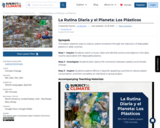
SYNOPSIS: This lesson explores ways to reduce carbon emissions through the reduction of disposable plastics in daily routines.
SCIENTIST NOTES: We have a problem with plastics; they are everywhere. And they are bad for the climate and our health. This lesson shows how some countries are trying to reduce the use of plastics. This lesson passed our scientific review process.
Tenemos un problema con los plásticos; están por todas partes. Y son malos para el clima y nuestra salud. Esta lección muestra cómo algunos países están tratando de reducir el uso de plásticos. Esta lección pasó nuestro proceso de revisión científica.
POSITIVES:
-This lesson can easily be integrated into a unit on daily routines, the environment, or the present tense.
-Students are exposed to ways that Latin American countries are leading the way in solving the plastics problem.
-The lesson engages students with two games, Quizlet live and Kahoot.
-The vocabulary related to plastic items is scaffolded so that students can independently navigate the Spanish-language websites and complete the final project with confidence.
ADDITIONAL PREREQUISITES:
-The activities presume novice-high Spanish-language proficiency.
-Students should be familiar with reflexive verbs in the present tense, verbs like gustar to express opinions, and daily routine vocabulary.
-To prepare to teach this lesson, teachers can learn about plastics and recycling.
-This NPR/Frontline report from 2020 and this in-depth Greenpeace España report analyze the limits of recycling as a solution to the plastic problem.
-Bioplastics are made from natural ingredients such as corn. This flier, produced by Break Free From Plastic, provides data about the drawbacks of this solution.
DIFFERENTIATION:
-The lesson can be shortened by eliminating the vocabulary activities in the Inquire section or eliminating either Parte 1 or Parte 2 in the Inspire section.
-The lesson can be extended for advanced students by including supplemental reading and listening activities.
-Students can explore the 2024 international treaty on plastics using this summary in Spanish of the 22 foundational points.
-This RTVE report "La Unión Europea dice adiós al plástico de un solo uso" includes text and a short video.
-Recicladores de base are an important part of the recycling process in many countries. Marce La Recicladora from Colombia has an informative YouTube channel.
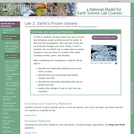
In Part A of this activity, students will learn about how sea ice forms and influences ocean currents around the globe. In Part B, they will look at how sea ice thickness changes over time. Finally, in Part C, students will use NSIDC sea ice index data to explore changes in sea ice extent on multiple time scales including months, years, and decades.
(Note: this resource was added to OER Commons as part of a batch upload of over 2,200 records. If you notice an issue with the quality of the metadata, please let us know by using the 'report' button and we will flag it for consideration.)
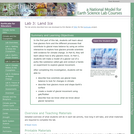
In the first part of this lab, students learn about land ice and the processes and timescales involved in glaciation. In Part B, they use an online interactive to explore how glaciers provide scientists with evidence for climate change. Finally, students use image processing software to measure how much area a real glacier has lost over time due to rising temperatures.
(Note: this resource was added to OER Commons as part of a batch upload of over 2,200 records. If you notice an issue with the quality of the metadata, please let us know by using the 'report' button and we will flag it for consideration.)
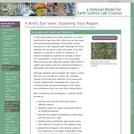
In Part A:Students are introduced to the global circulation patterns of the atmosphere and the oceans, and investigate how those circulation patterns might influence their local region.
In Part B: Students study surface ocean currents and then predict the pathway of a floating object dropped into the ocean at a particular point, maybe one closest to their own region. Then, using a computer model of ocean currents, they test their predictions.
(Note: this resource was added to OER Commons as part of a batch upload of over 2,200 records. If you notice an issue with the quality of the metadata, please let us know by using the 'report' button and we will flag it for consideration.)
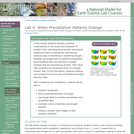
In this activity students develop a practical understanding of the causes and symptoms of drought. They read background articles and prepare a physical model to illustrate the role that soil moisture plays in preventing or promoting drought. Students use Google Earth to examine precipitation and streamflow data and use them to predict locations that are experiencing drought. They check their predictions by comparing them to a drought monitor map. In the final section, students examine and interpret the current map of the Palmer Drought Severity Index.
(Note: this resource was added to OER Commons as part of a batch upload of over 2,200 records. If you notice an issue with the quality of the metadata, please let us know by using the 'report' button and we will flag it for consideration.)
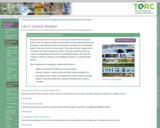
Students read articles from sources such as Environmental Protection Agency (EPA), NASA, the National Weather Service (NWS), and the National Oceanic and Atmospheric Administration (NOAA) and develop summaries of unusual weather patterns that have occurred in recent years. They read and share 2-page articles of indicators of climate change from the EPA. Then they examine and discuss maps of changing global temperature and precipitation patterns and relate the changes in climate to changes in the suitability of a region for a particular plant species.
(Note: this resource was added to OER Commons as part of a batch upload of over 2,200 records. If you notice an issue with the quality of the metadata, please let us know by using the 'report' button and we will flag it for consideration.)
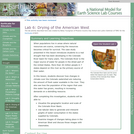
When populations live in areas where natural resources are scarce, conserving them becomes critical for survival. The case study presented in this lesson introduces students to a real drought that has been developing in the Colorado River basin for many years. The Colorado River is the major source of water for people in the driest part of the United States. More than 30 million people in 7 states depend on this river as the primary source of their water.
In this lesson, students discover how changes in climate over the Colorado watershed are reducing the amount of fresh water available in the river. They also see how the population of the region that uses this water has grown, resulting in increasing demands on a dwindling resource.
(Note: this resource was added to OER Commons as part of a batch upload of over 2,200 records. If you notice an issue with the quality of the metadata, please let us know by using the 'report' button and we will flag it for consideration.)
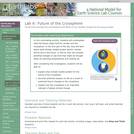
Students examine interactions and feedback between the cryosphere and atmosphere. In the first part of this investigation, students do a hands-on activity to explore albedo and how sea ice helps regulate global temperatures.
(Note: this resource was added to OER Commons as part of a batch upload of over 2,200 records. If you notice an issue with the quality of the metadata, please let us know by using the 'report' button and we will flag it for consideration.)
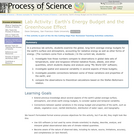
"Earth's Energy Budget and the Greenhouse Effect" is a lab activity in which students use computers and scientific applications software to access, display, describe, analyze, and interpret global, climate-related data sets related to the earth's energy budget and the greenhouse effect.
(Note: this resource was added to OER Commons as part of a batch upload of over 2,200 records. If you notice an issue with the quality of the metadata, please let us know by using the 'report' button and we will flag it for consideration.)

This lab introduces students and other interested users to the Neotoma Paleoecology Database and Neotoma Explorer. Neotoma DB is a public-access and community-supported repository of paleoecological data, mostly from the late Quaternary. These data are widely used by scientists to study species responses to past climate change.
(Note: this resource was added to OER Commons as part of a batch upload of over 2,200 records. If you notice an issue with the quality of the metadata, please let us know by using the 'report' button and we will flag it for consideration.)

In this lab, modified from Barbara and David Tewksbury's sea level rise lab, students use bathy/topo DEMs from NOAA to predict the location of shorelines after certain amounts of sea level rise and tsunami inundation. This is then combined with TIGER census data to get estimates of the number of people affected by the change in shoreline. Students then display their results with data driven map pages.
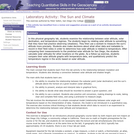
In this physical geography lab, students examine the relationship between solar altitude, solar declination, and temperature regimes. Using data collected in the field, mathematical relationships, and temperature records available on the Internet, students compare the insolation and climate in their location to that of other locations.
(Note: this resource was added to OER Commons as part of a batch upload of over 2,200 records. If you notice an issue with the quality of the metadata, please let us know by using the 'report' button and we will flag it for consideration.)

Short Description:
This lab manual is a cross-institutional project from British Columbia (BC), Canada that provides 24 labs to be implemented within first year post-secondary physical geography courses. The labs have been developed to be easily adapted for various course structures, durations, and differing laboratory learning objectives set out by instructors. Instructor notes are available for each lab that outline the instructional intent of the lab author, along with some suggestions for modifications. The lab manual is licenced under a creative common license (refer to licensing information) so that the lab modules can be modified as needed. The second edition of this lab manual was created for the onset of the 2021/22 academic year.
Long Description:
Physical geography lab exercises tend to be crafted for internal institutional use only. In light of the need to have online laboratory material for remote instruction, a group of geography instructors from across British Columbia (BC), Canada came together for this collaborative project with the goal of producing a cross-institutional open education resource (OER) laboratory manual for first-year post-secondary physical geography courses. The lab manual consists of 24 labs that cover an introduction to physical geography, weather and climate, biogeography, map and geospatial skills, hydrology, geomorphology, and landform identification. Many of the labs have a BC setting; however, they are useable across Canada and further abroad. The majority of the labs have been developed so that they can be done in any order to increase instructor flexibility and promote adaptability to differing course structures and durations. Many of the labs have students using live data, or built-in flexibility with datasets for instructors in order to prevent the lab exercises becoming static over time. The lab manual is licenced under a creative common license (refer to licensing information) so that the lab modules can be modified as needed by instructors to meet the learning outcomes of their students.
The second edition of this lab manual was created in the spring and summer of 2021 for the 2021/22 academic year and beyond. The second edition features substantial revisions to the labs and instructor notes for consistency and effectiveness, a reordering of the lab numbers, and two new labs (lab 07 and 19).
Word Count: 102946
(Note: This resource's metadata has been created automatically by reformatting and/or combining the information that the author initially provided as part of a bulk import process.)

Short Description:
This lab manual is a cross-institutional project from British Columbia (BC), Canada that provides 24 labs to be implemented within first year post-secondary physical geography courses. The labs have been developed to be easily adapted for various course structures, durations, and differing laboratory learning objectives set out by instructors. Instructor notes are available for each lab that outline the instructional intent of the lab author, along with some suggestions for modifications. The lab manual is licenced under a creative common license (refer to licensing information) so that the lab modules can be modified as needed. The second edition of this lab manual was created for the onset of the 2021/22 academic year.
Long Description:
Physical geography lab exercises tend to be crafted for internal institutional use only. In light of the need to have online laboratory material for remote instruction, a group of geography instructors from across British Columbia (BC), Canada came together for this collaborative project with the goal of producing a cross-institutional open education resource (OER) laboratory manual for first-year post-secondary physical geography courses. The lab manual consists of 24 labs that cover an introduction to physical geography, weather and climate, biogeography, map and geospatial skills, hydrology, geomorphology, and landform identification. Many of the labs have a BC setting; however, they are useable across Canada and further abroad. The majority of the labs have been developed so that they can be done in any order to increase instructor flexibility and promote adaptability to differing course structures and durations. Many of the labs have students using live data, or built-in flexibility with datasets for instructors in order to prevent the lab exercises becoming static over time. The lab manual is licenced under a creative common license (refer to licensing information) so that the lab modules can be modified as needed by instructors to meet the learning outcomes of their students.
The second edition of this lab manual was created in the spring and summer of 2021 for the 2021/22 academic year and beyond. The second edition features substantial revisions to the labs and instructor notes for consistency and effectiveness, a reordering of the lab numbers, and two new labs (lab 07 and 19).
Word Count: 104364
ISBN: 978-1-77420-209-8
(Note: This resource's metadata has been created automatically by reformatting and/or combining the information that the author initially provided as part of a bulk import process.)
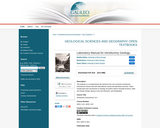
This textbook is a comprehensive lab manual for the core curriculum Introductory Geosciences classes with both informational content and laboratory exercises. Topics include basic laws and theories in Geology, the Earth's interior and plate tectonics, water and climate change, igneous rocks and volcanoes, and earthquakes.
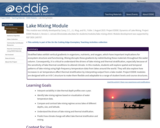
Stratified lakes exhibit vertical gradients in organisms, nutrients, and oxygen, which have important implications for ecosystem structure and functioning. Mixing disrupts these gradients by redistributing these materials throughout the water column. Consequently, it is critical to understand the drivers of lake mixing and thermal stratification, especially because of the sensitivity of lake thermal conditions to altered climate. In this module, students will explore spatial and temporal patterns of lake mixing using high-frequency temperature data from lakes around the world. They will also explore how increases in air temperature affect thermal stratification by interpreting output from a lake model. Project EDDIE modules are designed with an A-B-C structure to make them flexible and adaptable to a range of student levels and course structures.
(Note: this resource was added to OER Commons as part of a batch upload of over 2,200 records. If you notice an issue with the quality of the metadata, please let us know by using the 'report' button and we will flag it for consideration.)